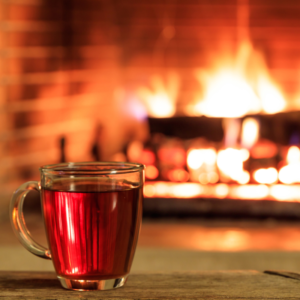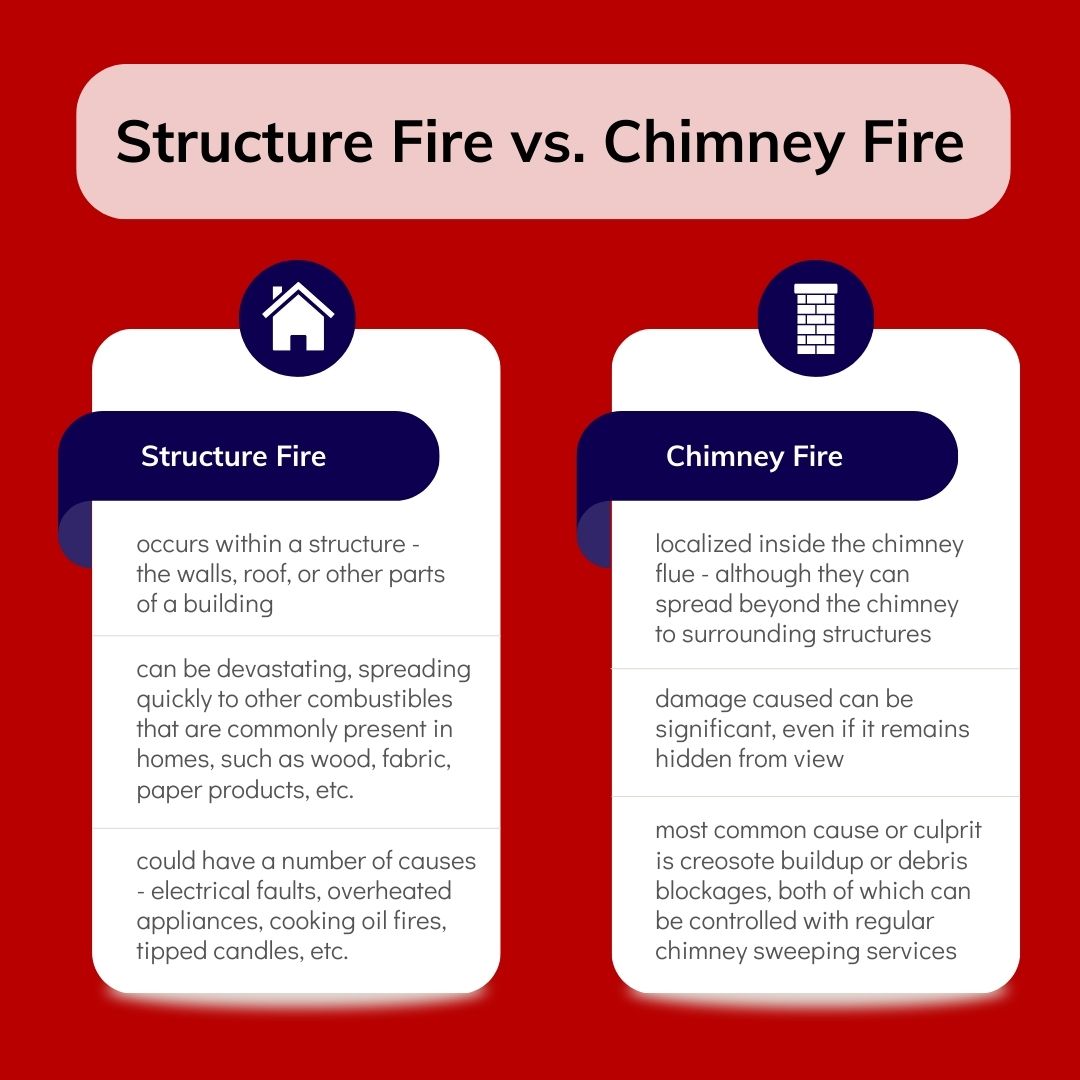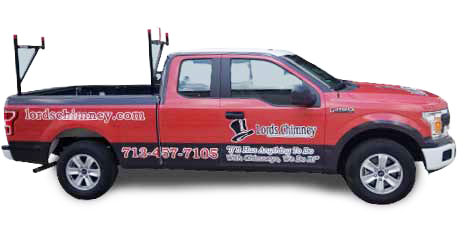Peaceful ambiance? Cozy comfort? Festiveness? Warmth?
A fire flickering in the fireplace checks all these boxes.
A home fireplace is an inviting asset, but it should always be used with proper caution so it’s a source of enjoyment, rather than worry. Thankfully, armed with a little knowledge and awareness, this is no problem.
Create Fires That Burn Cleanly
Not all fires are equal. Incomplete combustion or inadequate air supply can generate a smoky fire, causing creosote and soot to build up in your chimney. Here are ways to avoid this:
- Avoid using damp, diseased, or green (newly cut) wood. Good firewood is seasoned, which means it’s been aged or dried to burn as completely as possible. When seasoned, firewood will have visible checking (splits and cracks) and feel relatively lightweight.
- Use local firewood. This is for regional environmental health, which does indirectly affect your home. Using local firewood helps avoid the spread of tree diseases and pests from region to region, keeping them out of your neighborhood.
- Properly store firewood. Store chopped wood long enough for it to give a reading of 15-25% on a moisture meter. This will likely take at least six months if it’s freshly cut and split. Keeping the bottom of the woodpile off the ground with the top covered and the sides exposed to sun and air is ideal practice.
- Start well. Don’t use gasoline, charcoal starter, or other chemicals or accelerants to get your fire moving.
- Keep garbage out. Construction scraps, treated or painted wood, and household waste should never make their way into the fireplace. Some of these items release toxic chemicals, dark smoke, or lightweight particles when burned.
- Clear ash. Ash from previous fires should be cleared when it gets to about an inch thick. Otherwise, it can restrict airflow to the logs during your next fire.
- Open the damper. Be sure your damper is open so smoke can escape before you start a fire – and don’t close it until the fire is completely out.
Keep Your Fires Contained
You want your fire to be controlled and contained. This means taking measures to keep all embers in the fireplace and avoiding putting any combustible items where they could get too hot or be exposed to sparks.
 Use small pieces of wood. This will help ensure your wood is well-seasoned and burning cleanly, but also minimize chances of embers escaping as wood breaks down during a fire. Along these same lines, don’t overfill your fireplace.
Use small pieces of wood. This will help ensure your wood is well-seasoned and burning cleanly, but also minimize chances of embers escaping as wood breaks down during a fire. Along these same lines, don’t overfill your fireplace.- Maintain proper clearances. Rugs, curtains, and other flammable objects should be at least three feet away from your fireplace. Be vigilant about clearing away books or other items that may have accumulated too near before beginning each fire. And when you deck the halls, remember to keep the garlands and stockings a safe distance away.
- Use a firescreen. A metal firescreen helps contain sparks and prevent embers from rolling out onto furniture or rugs.
- Protect carpeting with a fireproof mat. If your fireplace is in a carpeted area, a fireproof rug can protect your carpet from burns if a spark does reach it.
Maintain Your System
Brick and mortar are durable, and chimney systems are built for longevity. With proper care and maintenance, they should serve you for a long time.
- Inspect your chimney annually. Your chimney should be checked over by a Chimney Safety Institute of America (CSIA) certified chimney sweep every year, without fail.
- Have your chimney swept. Your chimney sweep should also clean your chimney, removing any obstructions and accumulation of creosote or soot, annually – or more, if you’re a frequent user of your fireplace. If you notice dark flakes of creosote, you’re overdue for a sweep and shouldn’t use your fireplace until it’s been done.
- Cut back limbs. Branches that overhang your chimney can be a fire hazard or can cause physical system damage to your chimney during high winds, storms, or if they break.
- Be observant. Say you had your chimney inspected in the spring, but have recently noticed new cracks or discoloration in your masonry or warping on your chimney cap. Have it checked out – these can be signs you’ve had a chimney fire. Also check for nests or debris that should be removed.
- Ask about a chimney cap. If you don’t have one, you should – a chimney cap has a metal top to prevent critters and leaves from entering your chimney and metal mesh sides that arrest sparks while venting smoke and flue gases.
Be Equipped for Safety
There are some basic safety tips everyone should know before lighting a fire in their home.
 Invest in smoke alarms and carbon monoxide detectors. Check them monthly and replace batteries annually or if they fail a monthly check. Also, be sure your family knows how to exit the home and where to meet if they do ever go off.
Invest in smoke alarms and carbon monoxide detectors. Check them monthly and replace batteries annually or if they fail a monthly check. Also, be sure your family knows how to exit the home and where to meet if they do ever go off.- Crack a window. If possible, when the fireplace is going keep a window open a bit to increase ventilation.
- Keep a fire extinguisher handy. Know where your fire extinguisher is stored and how to use it.
- Be present. Your presence with the fire is a big component of safety. Be sure your fire is either attended or out. This is the case even if you’re home (i.e. your fire should be out before you head to bed).
- Protect children and pets. Keep fireplace tools out of reach and away from children and pets. Install fireplace doors or hearth gates to protect your loved ones from hot surfaces.
Partner With Us
We’re proud to be your partners in bringing the warmth and ambiance of a fireplace into your home and maintaining it for years of enjoyment. If you have questions about fireplace care, safety, or upgrades, give us a call today!
Reach out to our Houston location at 281-786-0507, our Beaumont location at 409-240-0013, or you can contact us online. We’d love to hear from you soon.
Here at Lords Chimney, we take pride in putting the safety and satisfaction of our customers above it all. You won’t find experienced, professional sweeps like ours anywhere else, and we can provide you with the knowledge and advice you’re looking for to have the safest and most enjoyable holiday season yet.
Now, one key ingredient in hosting a successful Christmas gathering is a warm, blazing fire in the fireplace. That is unless your fire-building strategies always prove to be less than successful. If you want to avoid a smoke-filled living space, along with the countless other threats that accompany a poorly constructed fire, read up on some of our guidelines below.
Invest In An Inspection & Sweeping
First things first, be certain to get your annual inspection scheduled before lighting any fires and have a sweeping completed if excess creosote was spotted in your flue. By getting an inspection done every year, you guarantee more efficient fires, and you avoid countless potential threats, such as house and chimney fires, carbon monoxide exposure, gas leaks, smoke back-up, and more.
Just be sure you book this maintenance with a team of CSIA Certified Sweeps to ensure you get the most knowledgeable and in-depth analysis possible. The crew here as Lords Chimney has trained with the CSIA, and we work with a number of other reputable organizations, as well, such as the NFI and the NCSG. We would love to set you upright, so book your inspection with our experienced staff today!
Now, what you use for fuel plays an integral part in how efficiently your fires burn, and it has an impact on the health of your chimney, too. It’s essential that you burn only well-seasoned firewood in your fireplace and nothing else besides it. Although it’s tempting to throw trash in there from time to time, especially in a time of year where you’re using a lot of wrapping paper, paper plates, plastic silverware, and more, but burning these materials increases the amount of creosote that forms in your flue, and it can create some pretty smoky fires, too.
It’s also important to avoid burning wet or unseasoned wood. If your fuel hasn’t adequately dried out, then acidic water will break down your chimney’s interior system, and your fires won’t burn as nicely, either. If you want heat and efficiency from your fireplace, then well-seasoned wood is the only thing you should be burning!
How do you know that your logs are ready for use? Well, if you season your own wood, it should be fine to burn after about six months of airing out in a well-protected, but open area outside. (Be sure to store it off of the ground, too!) If you are purchasing fuel, then some key characteristics to watch out for are.
- Logs that are lightweight.
- Pieces that make a hollow-sounding noise when smacked together.
- Logs that are split and dark on the ends.
- Wood that is cut to a shorter length.
Open Your Damper
Ever light a fire only to have smoke start pouring into your living room? This is unhealthy, uncomfortable, and it can leave you with an odor that is hard to erase. It’s a common mistake for homeowners to forget to open their damper before lighting things up, so be sure yours is open before getting your evening going.
Also, if your throat damper is rusting, eroding, or getting stuck all the time, consider upgrading to a top-sealing damper. These offer an effective seal with a rubber gasket, and they work alongside your chimney cap to keep out animals, downdrafts, and excess debris. Ready to make the switch? Talk with our team today.
Warm The Flue
It’s a good idea to light a roll of newspaper and hold it in your flue for a bit to get things primed and ready before lighting your fire. Why is this recommended? Well, otherwise you’ll be fighting the cold air in your chimney, which can overpower any smoke going up and push it back into your home. If you heat things up ahead of time, you could save yourself a lot of stress and hassle.
Study Fire Safety Tips
A fire in your home means there is always an increased risk of experiencing a gas leak, house fire, chimney fire, and more. Be sure you know the best ways to avoid a disaster in your home and have a plan in place should a fire occur. Map things out ahead of time and have your family practice different escape routes. It’s also important to pick a meeting spot outside of the home so that everyone knows where to meet up and check-in in the event of an emergency.
Also, remember to never leave a fire unattended. When it’s late and you’re tired, it may be tempting to simply fall asleep and let the flames die out on their own, but this has caused many accidents. It simply isn’t worth the risk. We also urge all of our customers to invest in multiple smoke and carbon monoxide detectors, as these are often the first or only things to offer any warning signs of danger.
Don’t Wait – Call Lords Chimney Today
If your chimney is in need of care, then there’s no time to lose. Count on the qualified and experienced technicians at Lords Chimney soon. We serve the counties of Harris, Fort Bend, Montgomery, Austin, Galveston, and Wharton, and we would love to help you out. Call today!
Nothing beats the modern convenience of a great working dryer. In less than an hour, you’re provided with clean, warm clothes, so you can face whatever the day has in store for you. However, what if things aren’t working properly? When you are forced to run cycle after cycle in hopes of getting your laundry completely dry, something isn’t right.
At Lords Chimney, we can make sure this doesn’t happen to you. We are CDET certified by the CSIA to clean dryer vents in homes all throughout our service area. We have helped countless customers feel safer and more at ease with this service, and we want to help you out, too!
Learn more about how your venting system works. Then, give us a call today, so that we can give your more information about just what it is that we can do for you. We’re excited to help you out soon!
Your Dryer System
Once heated air works its way through your dryer, it needs somewhere to escape. This air passes through the lint screen, then goes through a series of ducts, where it eventually ends up outside, safely away from the interior of your home. This is one reason why cleaning that lint trap after every drying cycle is so important!
While this process seems easy enough, the lint trap unfortunately cannot catch every piece of lint that comes its way. As various pieces escape through, they enter your duct system, where they get trapped until they are physically removed by a certified technician. It is important to have this excess debris cleaned out on a regular basis (at least once per year).
Why Are Clean Vents Important?
Clean vents are important for multiple reasons. First and foremost, dirty vents can trigger fires. Thousands of fires occur every year due to home dryers and the majority of these are caused by clogged up venting systems. With something this serious, it’s not worth taking any chances. Have your vents cleaned out, so that your home stays as protected as possible.
Fires aren’t the only threat. Hazardous toxins can easily back up into your home when they are not given the chance to escape outside. With nowhere else to go, they turn back in the air you and your family breath in every day. This can lead to some serious illness, and it has landed many people in hospitals over the years.
It’s clear that good venting is vital to keeping a safer home. You’ll want trained and experienced techs on the job! Turn to Lords Chimney, so you know that every step along the way will be taken care of to the highest standards possible.
When you’re ready, give us a call at 281-497-4000. We can’t wait to help you out soon. Count on us for all of your fireplace, chimney, and dryer vent needs!



 Use small pieces of wood.
Use small pieces of wood.  Invest in smoke alarms and carbon monoxide detectors.
Invest in smoke alarms and carbon monoxide detectors. 


